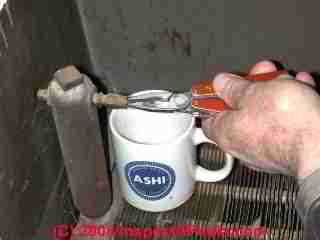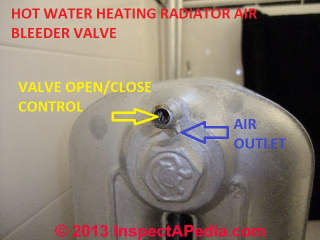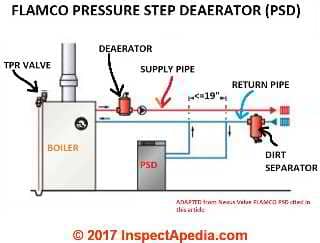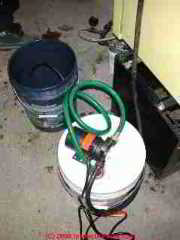 Air bound Hot Water Heating System Diagnosis & Repair
Air bound Hot Water Heating System Diagnosis & Repair
- POST a QUESTION or COMMENT about troubleshooting problems bleeding the air out of hot water heating system radiators, baseboards, convectors etc.
Air in heating system pipes, baseboards, radiators makes a gurgling noise and ultimately leads to loss of heat.
How to diagnose & fix trapped air in heating systems causing cold baseboards, convectors or radiators: beginning right here we describe six different causes & cures for cold radiators and baseboards due to air trapped in the heating system. These diagnostic routines are described in the order they should be tried.
We start by confirming that we think the problem is that air trapped in the hydronic (hot water) heating system piping, boiler, radiators, baseboards or convectors is preventing heat from being delivered to the building.
This article series provides a detailed guide fixing no-heat calls in which the heating boiler and circulator are running but heat is not being delivered to one or more building areas.
InspectAPedia tolerates no conflicts of interest. We have no relationship with advertisers, products, or services discussed at this website.
How to Recognize & Fix Problems Caused by Air In Hot Water Heating System Pipes, Radiators, Baseboards
 Air in heating system piping can cause gurgling noises and eventually, when enough air is in the pipes, heat will be lost as hot water won't continue to circulate.
Air in heating system piping can cause gurgling noises and eventually, when enough air is in the pipes, heat will be lost as hot water won't continue to circulate.
After cofirming that the building is calling for heat but some areas are not getting it, here we explain how to find where the trapped air is actually located and we give a series of steps to fix the trouble, starting with a simple simple procedure for bleeding trapped air at registers or baseboards.
[Click to enlarge any image]
If necessary there are additional methods used to remove air from air-bound hot water heating systems using two different service procedures to force air out of airbound pipes in a hot water heating system.
Our photo at above left (red arrow) shows a conventional air bleeder valve on a cast iron hot water heating radiator.
The blue arrow shows the little nipple out of which air will hiss when the valve is opened (using a rectangular "skate key" type wrench or key available from your plumbing supplier).
The yellow arrow shows the rectangular valve control that is turned with a "skate key" or if necessary another tool to open or close the air bleeder.
Close the valve as soon as water starts squirting out from this opening.
Watch out: if an air vent is not installed properly it may make matters worse, actually admitting air into the hydronic heating system and increasing its tendency to become airbound.
Article Contents
- COLD RADIATORS/BASEBOARDS What to Check First
- 5 APPROACHES to REMOVING AIR from heating boilers & piping
- DIAGNOSE PERSISTENT AIR IN HEATING PIPING
- OTHER CURES for PERSISTENT AIR IN HEATING PIPING
What to check first if a hot water heating radiator or baseboard is not getting hot
Check hot water baseboards, radiators, or heating convectors:
if some of these heating devices are hot and others cold, are they all on the same heating zone?
Feel the hot water piping leaving the heating boiler - it should be hot when the boiler is running and the thermostat is calling for heat.
If the building has multiple heating zones each zone will be controlled by its own thermostat and each heating zone will either have its own hot water circulator pump (controlled by a thermostat and pump relay switch), or each hot water heating zone will have its own thermostat and a zone valve that opens to let a common circulator pump send hot water through that individual heating zone
Are all of the thermostats turned up high enough to call for heat in each heating zone?
If some heating baseboards or radiators are hot and others cold
and we're sure that they're on the same heating zone, then the system is probably air-blocked.
Watch out: it is not obvious to people not expert in hot water heating systems, but the circulator pump on a typical hot water (hydronic) heating system does not have enough oomph to push a bolus of trapped air around through the heating system pipes.
If more than small bubbles of air remain trapped inside the heating piping the circulator may spin without actually pushing hot water through the system. By purging the trapped air we get the hot water circulating again.
See details at COLD HEATING BASEBOARD / RADIATOR REPAIR
...
5 Approaches to Removing Hydronic Air / Fixing an Air-Bound Hydronic Heating System
 In sister articles we discuss these approaches to removing air that is preventing proper water circulation in a hydronic (hot water) heating system.
In sister articles we discuss these approaches to removing air that is preventing proper water circulation in a hydronic (hot water) heating system.
You are likely to find at least two of these automatic and manual air removing devices on both residential and commercial hot water heating systems: air bleeder valves, both automatic and manual, and air scoops/separators.
- AIR BLEEDER VALVES - installed at the boiler and at other strategic locations automatic or manual air bleeders remove air from the system at high points.
- AIR SCOOPS SEPARATORS PURGERS are specialty valves that in essence are a more-sophisticated "air bleeder valve" - the first de-aeration approach in this list. Example air separator products include
Nexus Valve Flamco Flamcovent Smart air separator. Retrieved 2017/12/14, original source: http://www.nexusvalve.com/products/categories/?cid=10065&tid=10027
Excerpt from the company's web page:
The Flamcovent Smart air separator removes even the smallest microbubbles from the system water. It is virtually maintenance-free with a negligibly low flow resistance. The Flamcovent Smart can be incorporated in a variety of heating and cooling systems and in every desired direction. - AIR BOUND HEAT SYSTEM REPAIR by PUMP - using a pony pump to force air out of an air-bound heating system
- AIRBOUND HEAT SYSTEM REPAIR by WATER FEED VALVE - using a pressure over-ride on the boiler water feeder to try to force air out of an airbound heating system
- PRESSURE-STEP DEAERATORS [PDF] - Nexus Valve Flamco Pressure Step Deaerator, Aalberts Industries, 9982 E. 121st St., Fishers IN 46037, USA Tel: 888-900-0947, Website: www.nexusvalve.com Retrieved 2017/12/14, original source: http://www.nexusvalve.com/uploads/downloads/Flamco%20PSD%20FINAL.pdf
Excerpts:
Pressure-Step Deaerators or PSDs are a more-recent innovation used to remove entrained air in hot (or chilled) water hydronic systems.
"Entrained" air can be taken to mean air that is dissolved in the hydronic system's water. As water is warmed that entrained air changes to gas bubbles that in quantity can result in an air-bound piping system.
A pressure-step deaerator uses vacuum to "deaerate" or remove air entrained in the hydronic system's water.
The PSD from FLAMCO uses a combination of duplexed pumps, isolation valves, and a vacuum deaerator cylinder along with additional controls and valves to remove air dissolved in the system water supply.
Technical note: building plumbing systems may include other water system air removal devices not associated with heating and cooling, such
...
Diagnose Causes of Persistent Air in Heating System Piping: noises, cold baseboards/radiators
Diagnose & fix recurrent noise of air in hot water (hydronic) heating piping, baseboards, radiators:
If your service technician bled all of the air from the heating system piping but the problem returns, then most-likely the problem is one of these three causes:
- The service technician did not actually get all of the air out of all sections of heating system piping, baseboards, radiator, boiler.
For example, if air bleeding is incomplete or not done properly, even though the plumber says the job is "done" it might not be.
For example, unless the heating technician or plumber uses a pump to force water through the system to flush out all air, some air may be left in piping, especially at longer horizontal runs.
See details at AIR BOUND HEAT SYSTEM REPAIR by PUMP
- Your heating system is missing automatic air bleeder valves or the ones installed are not working.
If your service technician successfully bled all of the air from the heating system piping but the problem returns, then most-likely the problem is that either your system is missing automatic air bleeder valves or the ones installed are not working.
After having the service tech confirm that the primary air removal device at the boiler,
see AIR SCOOPS SEPARATORS PURGERS
and check that all other automatic air bleeder devices installed on the heating system and its piping are working:
See AIR BLEEDER VALVES - Check for leaks in the heating system boiler, controls, or piping.
In addition to making sure that the two key automatic air removal devices that we mentioned above,
look for signs of a leak anywhere in the system piping or at the boiler or controls.
A water leak out is also a possible air leak in when the boiler is in an off cycle and is cooling down. - Other air removal and heating system air noise remedies
Be sure that you have reviewed all 9 of the air-bound heating system cures just below on this page.
...
Cures for Air in Heating Systems
 Our discussion of radiators or baseboards that do not get hot when they should includes the articles listed below explaining how to get rid of air in hot water or hydronic heating systems in order to prevent or cure air-bound heating systems (sections of baseboard or radiators that don't get hot).
Our discussion of radiators or baseboards that do not get hot when they should includes the articles listed below explaining how to get rid of air in hot water or hydronic heating systems in order to prevent or cure air-bound heating systems (sections of baseboard or radiators that don't get hot).
- AIR BLEEDER VALVES - Guide to manual and automatic air bleeder valves & vents for hot water type heating systems:
how to find and use manual and automatic air bleeders to fix an air-boundheating system causing cold radiators convectors, or baseboards or noisy bubbling, gurgling heating pipes.
The air bleeder valve article series also explains how to troubleshoot, fix, install, or repair manual air purging or air bleeding valves on heating equipment. Some of these valves also work on cold water used in chilling and cooling equipment.
at AIR BLEED VALVE INSTALLATION. - AIR SCOOPS SEPARATORS PURGERS: guide to automatic air purging devices:
since on many hot water heating systems a key air bleeding or air vent point is at the air scoop or air separator closer to the boiler.
A quick visual inspection can tell us if there is obvious leakage, corrosion, or clogging of some automatic air separator devices, and fdor some automatic air purge valves, a simple step of opening a valve cap may be all that's needed to restore the valve to operation - or perhaps we close the cap to stop dripping there.
Air vents necessary for steam radiators to get hot for steam heating systems are discussed separately
at STEAM VENTS. - AIRBOUND HEAT SYSTEM REPAIR by WATER FEED VALVE - describes how to use built-in controls and valves to force air out an air-bound heating system
whose radiators, convectors, or baseboards are not warming up. We try this approach if trapped air in the heating system piping or baseboards is not being successfully vented by the manual or automatic vents already installed. - AIR BOUND RADIANT HEAT - a no heat problem in one zone of radiant heating may show up as a "vacuum"
or as "heat is running backwards" or may be mistaken for a thermostat or control problem, depending on the controls installed and where you look - AIR BOUND HEAT SYSTEM REPAIR by PUMP - (photo above) how to use a portable pump, short sections of garden hose, and heating system valves to force air out an air-bound heating system whose radiators, convectors, or baseboards are not warming up.
Photo above: a pony pump and hoses being prepared to force water through an air-bound heating system to push un-wanted air out of piping when air bleeders themselves are not doing the trick. - STEAM VENTS - are installed around the middle of one end of steam heat radiators to vent air as steam rises into the radiator.
These vents are automatic. If the steam radiator does not heat and its feed valve is open try replacing the steam vent. - WATER FEEDER Valves, Hydronic - a defective automatic water feeder valve on a hot water heating boiler
can result in too little starting water pressure in the system - radiators on upper floors may fail to receive heat.
Gurgling noises in the heating system pipes or low heating boiler water pressure could be due to a clogged or damaged pressure-reducer water feed valve. Here is an example:
After I was unable to figure why the furnace had a low water level that led to gurgling in the radiators, I decided to change the auto-fill valve above the expansion tank. I'd already changed the tank the week before but decided to cheap out and reuse the old valve.
When I disconnected and upended the tank/valve it spilled a bunch of black sulfur laden water out. The sulfur flakes may have clogged the screen or valve for as much as several years. - M.F. 12/24/2014
On a steam heating boiler a defective automatic water feed valve can cause the heating system to shut down completely or can lead to boiler damage or even unsafe conditions. In this article we discuss problems with water feeder valves that also control water pres sure in the boiler and we explain how to adjust the water feeder valve and thus boiler water pressure.
Here are two air-removal remedies that can work
AIRBOUND HEAT SYSTEM REPAIR by WATER FEED VALVE - and if this doesn't work then
WATER FEEDER VALVE, STEAM is the article you want if your heating system is by steam rather than hot water. - At BOILER PRESSURE & TEMPERATURE SETTINGS we discuss the pressures needed for hydronic or hot water heating systems
- a taller building needs higher starting (cold) pressure in the heating boiler. - At OIL HEAT NOISE DIAGNOSIS we discuss the diagnosis and repair of other heating system noises on both oil and gas fired heating equipment.
...
Technical Resources on Venting Air From Heating Systems
- Grundfos, VENTING AIR from HEATING SYSTEMS [PDF] Grundfos, Poul Due Jensens Vej 7
DK-8850 Bjerringbro, Denmark
Tel.: +45 87501400
retrieved 2020/04/15, original source: https://www.grundfos.com/service-support/encyclopedia-search/air-vent.html
GRUNDFOS Kansas City 17100 West 118th Terrace Olathe, Kansas 66061 USA Phone: (913) 227-3400 www.grundfos.us
GRUNDFOS Canada 2941 Brighton Road Oakville, Ontario L6H 6C9 Canada Phone: +1-905 829 9533 www.grundfos.ca
GRUNDFOS México Boulevard TLC No. 15 Parque Industrial Stiva Aeropuerto C.P. 66600 Apodaca, N.L. México Phone: 011-52-81-8144 4000 Fax: 011-52-81-8144 4010 www.grundfos.mx
Excerpt:
The following are commonly used components and methods to remove air:
Air vent screws mounted on radiators and convectors, etc
Air pots which are placed at high points in the system, often where the pipe goes from horizontal to a vertical drop
Automatic air vents placed in the same way as air pots
Micro-bubble air vents located in front of main pumps where the pressure is lowest
Degassing using a pressure reduction technique where a portion of the system water is diverted to a pressureless diaphragm tank in the system’s pressure-holding and expansion system
Air that is not removed from the system will collect at high points in the heating system and create air pockets. Worst case is that circulation in the heating system comes to a standstill, and the system loses its ability to heat the building. - Boilers, Boiler Conversions, James E. Brumbaugh, ISBN 0-672-23389-4 (v. 1) Volume II, Oil, Gas, and Coal Burners, Controls, Ducts, Piping, Valves, James E. Brumbaugh, ISBN 0-672-23390-7 (v. 2) Volume III, Radiant Heating, Water Heaters, Ventilation, Air Conditioning, Heat Pumps, Air Cleaners, James E. Brumbaugh, ISBN 0-672-23383-5 (v. 3) or ISBN 0-672-23380-0 (set) Special Sales Director, Macmillan Publishing Co., 866 Third Ave., New York, NY 10022. Macmillan Publishing Co., NY
...
Reader Comments, Questions & Answers About The Article Above
Below you will find questions and answers previously posted on this page at its page bottom reader comment box.
Reader Q&A - also see RECOMMENDED ARTICLES & FAQs
On 2019-12-04 - by (mod) - keep losing heat in the same zone
Beau
You might want to look for a leak that's letting air enter the troublesome zone.
On 2019-12-03 by Beau
I have 3 zones and keep losing heat in the same zone . tech replaced zone valve 2 wks later no heat same zone, tech bled a lot of air out of that zone had heat for a wk , now no heat in that zone again
On 2018-06-12 - by (mod) - Is there a standard noise standard for mosques?
Radwan,
Please see HEALTH RELATED NOISE COMPLAINTS at https://inspectapedia.com/noise_diagnosis/Noise_Impact_on_Health.php
where I will repeat your question and give a more-detailed reply.
Editor
On 2018-06-12 by Radwan Almasri
Thank you very much
Is there a standard noise standard for mosques
best regards
Radwan Almasri
masri.radwan@gmail.com
On 2018-05-30 - by (mod) - Is an automatic air vent a necessary addition?
Nick
If you are hot water or hydronic heating system doesn't have working automatic air vents then a good time to install them would be when you're doing other work on the system such as putting in a new expansion tank. Without automatically venting air your system can become Airbound and you may lose heat.
That's a completely separate problem from having a waterlogged heating system expansion tank.
On 2018-05-30 by Ryannicky@opt online.net
Is an automatic air vent a necessary addition when installing a new expansion tank?
...
Continue reading at AIR BOUND HEAT SYSTEM REPAIR by PUMP or select a topic from the closely-related articles below, or see the complete ARTICLE INDEX.
Or see AIR-BOUND HEATING SYSTEM FAQs - questions & answers posted originally at this article
Or see these
Recommended Articles
- AIR-BOUND HEATING SYSTEMS - home - you are on this page
- AIR BOUND HEAT SYSTEM REPAIR by PUMP
- AIRBOUND HEAT SYSTEM REPAIR by WATER FEED VALVE
- AIR BLEEDER VALVES
- AIR SCOOPS SEPARATORS PURGERS
- COLD HEATING BASEBOARD / RADIATOR REPAIR
- DIAGNOSE & FIX HEATING PROBLEMS-BOILER - home
- WATER TANK BUBBLING / GURGLING NOISE DIAGNOSIS
Suggested citation for this web page
AIR-BOUND HEATING SYSTEMS at InspectApedia.com - online encyclopedia of building & environmental inspection, testing, diagnosis, repair, & problem prevention advice.
Or see this
INDEX to RELATED ARTICLES: ARTICLE INDEX to HEATING SYSTEMS
Or use the SEARCH BOX found below to Ask a Question or Search InspectApedia
Ask a Question or Search InspectApedia
Try the search box just below, or if you prefer, post a question or comment in the Comments box below and we will respond promptly.
Search the InspectApedia website
Note: appearance of your Comment below may be delayed: if your comment contains an image, photograph, web link, or text that looks to the software as if it might be a web link, your posting will appear after it has been approved by a moderator. Apologies for the delay.
Only one image can be added per comment but you can post as many comments, and therefore images, as you like.
You will not receive a notification when a response to your question has been posted.
Please bookmark this page to make it easy for you to check back for our response.
Our Comment Box is provided by Countable Web Productions countable.ca
Citations & References
In addition to any citations in the article above, a full list is available on request.
- Installation Guide #200, The Hydronics Institute, 35 Russo Place, Berkeley Heights, NJ 07922
- Our recommended books about building & mechanical systems design, inspection, problem diagnosis, and repair, and about indoor environment and IAQ testing, diagnosis, and cleanup are at the InspectAPedia Bookstore. Also see our Book Reviews - InspectAPedia.
- In addition to citations & references found in this article, see the research citations given at the end of the related articles found at our suggested
CONTINUE READING or RECOMMENDED ARTICLES.
- Carson, Dunlop & Associates Ltd., 120 Carlton Street Suite 407, Toronto ON M5A 4K2. Tel: (416) 964-9415 1-800-268-7070 Email: info@carsondunlop.com. Alan Carson is a past president of ASHI, the American Society of Home Inspectors.
Thanks to Alan Carson and Bob Dunlop, for permission for InspectAPedia to use text excerpts from The HOME REFERENCE BOOK - the Encyclopedia of Homes and to use illustrations from The ILLUSTRATED HOME .
Carson Dunlop Associates provides extensive home inspection education and report writing material. In gratitude we provide links to tsome Carson Dunlop Associates products and services.

